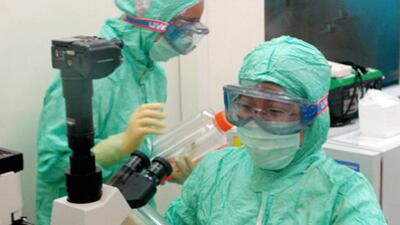On a September morning in 1928, Scottish biologist Alexander Fleming noticed one of his cultures had been contaminated by a fungus, which was killing staphylococci bacteria in his petri dish. Eighty-one years later, the substance produced by the Penicillium notatum fungus is still in wide use as an antibiotic.
Fleming’s discovery is indisputably one of the most important moments in the history of modern medicine. But had The Daily Beast curated a list of the previous decade’s biggest medical breakthroughs in 1929, would Fleming’s accidental find have made it? It seems unlikely: It took 17 more years to develop a stable, mass-producible form of penicillin.
Click Below for The Daily Beast’s list of the most startling medical discoveries of the last 10 years.
GALLERY: Our List: Most Startling Medical Discoveries of the Last 10 Years (PHOTOS)

Such is the nature of medical innovation: Entire careers, innumerable dead ends, and uncountable sums of money spent solving health problems are abridged, with the benefit of hindsight, into stories of single moments and heroic individual researchers. Many of the breakthroughs on The Daily Beast’s list of major medical discoveries of the last decade are steps on a continuum of discovery and progress—important midpoints in research and treatment that might one day be elided in favor of good stories like Fleming’s.
Our list covers innovation across several different categories, including new drugs (for cancer and HIV), vaccinations (like Gardasil, the HPV vaccination), and surgical and diagnostic techniques (such as natural orifice surgery and prenatal genetic blood tests). We also explain medical techniques that have been refined (such the use of drug-eluting stents in interventional cardiology), as well as research breakthroughs, such as the mapping of the human genome and advances in stem-cell research.
One of the most important advances of the decade is the newly discovered ability to give adult stem cells some of the important properties of embryonic stem cells, by inducing pluripotency, or the ability of one cell to morph into any cell in the body. Not only does this help sidestep ethical concerns over using lines derived from human embryos for research, but it opens up a much larger supply of stem cells for medical use. “The embryonic research is a necessary tool to understand the work,” says Michael J. Dixon, president of UNeMed Corp., a division of the University of Nebraska Medical Center that helps bring the university’s discoveries to the market. “But there’s never going to be a large enough supply of embryonic cells to use.”
While stem cells allow researchers to make progress in treating once-hopeless afflictions like Parkinson’s disease and spinal cord injuries, important advances have also been made in the treatment of the top two killers in the U.S.—heart disease and cancer.
“If you were asking me about ’89 to ’99, there was not nearly so much change,” says Dr. Michael Fisch, chairman of the department of general oncology at the M.D. Anderson Cancer Center. “There has been prolific change from ’99 to now.” Fisch sees a number of important developments in the diagnosis and treatment of cancer. One of these is targeted therapy, which attacks the molecules that cause cancer, instead of just stopping the duplication of cancer cells, as chemotherapy attempts to do. “There’s a whole armory of brand-new oral drugs that have real impact on the way we treat patients,” Fisch says. “That’s a big deal.”
Targeted therapy drugs like imatinib mesylate—marketed as Gleevec—erlotnib, and gefitnib are offering new hope to patients with gastrointestinal tumors, lung cancer, and deadly blood cancers such as chronic mylogenous leukemia. These new drugs allow doctors to make “a gigantic impact on a small group of patients,” according to Fisch. “All our research and standards of care are set up for what affects a broad number of people. We need to divide those big cancer categories into molecular subsets. And that is a big enterprise, and it’ll take a redesign of the way we do research.”
In cardiology, the development of stents that release drugs after being inserted into a coronary artery could significantly reduce problems with restenosis—or the narrowing of the blood vessel—that can sometimes be a problem after heart surgery. “If you project that to, say, the next five to 10 years, the next-generation stents will be less of an irritant yet produce the same efficacy,” says Dr. John Lasala, chief of interventional cardiology at Barnes Jewish Hospital in St. Louis.
Older treatments, too, have been refined and improved, in part by consolidating many drugs into one. The 2000s saw the introduction of the one-a-day HIV pill, Atripla—a huge boon to HIV-positive patients who have difficulty maintaining a strict drug regimen. And Pentacel is a five-in-one vaccine that immunizes children against diphtheria, polio, tetanus, influenza B, and whooping cough.
When we look back at the years from 2000 to 2009 in several decades, though, it’s worth remembering the lessons of penicillin. Medical innovations that haven’t made our list may then seem far more consequential—accidental findings and overlooked discoveries, research being made without hype or publicity, investigation put into motion now that could change the face of medicine, as much as Alexander Fleming cleaning his lab once did.
Max Read is a writer living and working in New York City.






